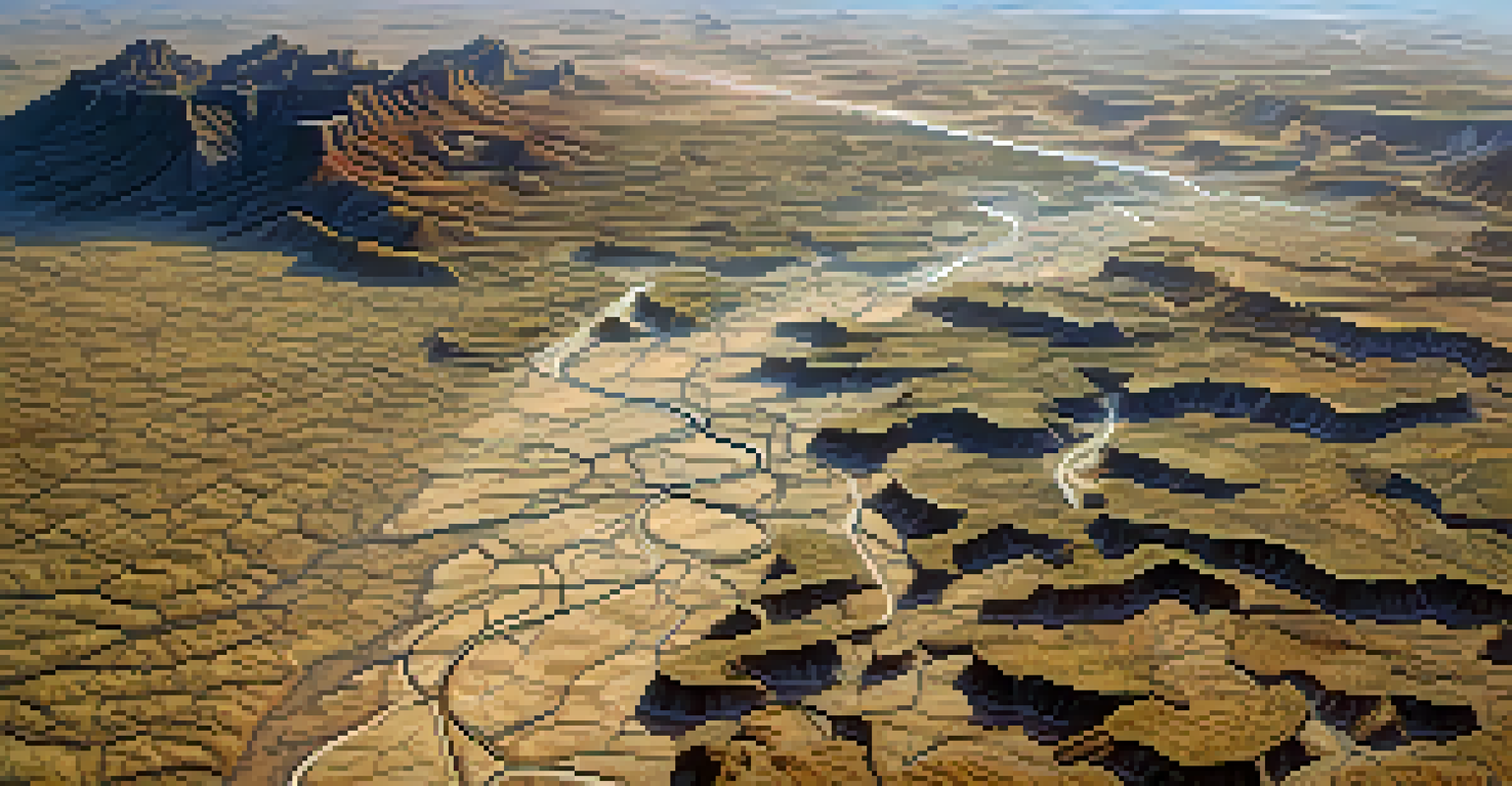The Impact of Arizona's Geography on Drug Trafficking Routes

Arizona's Geographical Features and Drug Trafficking
Arizona's diverse geography significantly impacts drug trafficking routes. The state's rugged mountains, vast deserts, and extensive border with Mexico create a unique landscape that traffickers exploit. This topography not only provides natural cover but also influences the methods traffickers use to transport drugs.
Arizona's diverse geography significantly impacts drug trafficking routes.
For instance, the Sonoran Desert serves as a major corridor for smuggling, with its remote areas being ideal for clandestine operations. The isolated terrain allows traffickers to move drugs undetected, using off-road vehicles and footpaths. This not only complicates law enforcement efforts but also highlights the challenges posed by Arizona's geography.
Additionally, urban areas like Phoenix and Tucson serve as distribution hubs. Their proximity to the Mexican border makes them strategic points for traffickers to move drugs further into the United States. As a result, understanding Arizona’s geography is crucial for developing effective strategies against drug trafficking.
The Role of the U.S.-Mexico Border in Trafficking
The U.S.-Mexico border plays a pivotal role in Arizona's drug trafficking dynamics. Stretching over 1,900 miles, this border is one of the most frequently crossed in the world. Arizona's 373-mile stretch of this border is particularly significant, as it is often targeted by drug cartels looking to smuggle narcotics into the U.S.

Cartels utilize various methods to cross the border, from tunnels to vehicles, making it a constant challenge for border security. The geography of Arizona, with its rugged mountains and sparse population along the border, provides ideal conditions for these illicit activities. The remoteness allows for easier evasion of law enforcement efforts.
Geography Shapes Trafficking Routes
Arizona's rugged terrain and extensive border with Mexico create complex challenges for drug trafficking and law enforcement efforts.
Moreover, the border's proximity to major highways facilitates the quick distribution of drugs across the country. Once drugs are smuggled into Arizona, traffickers can easily transport them to larger cities, expanding their reach. This interconnectedness between geography and trafficking routes underscores the complexities of combating drug smuggling.
Climate and Its Influence on Drug Trafficking
Arizona's climate also impacts drug trafficking operations in the region. The state's hot, arid conditions create challenges for both traffickers and law enforcement. While the heat can hinder the physical endurance of those involved in smuggling, it also has a unique effect on drug storage and transport.
The impact of drug trafficking extends beyond just law enforcement; it affects communities across Arizona.
For example, the high temperatures can degrade certain substances, prompting traffickers to develop methods for keeping drugs viable during transport. This might include timing shipments for cooler parts of the day or using specific vehicles designed for insulation. Such adaptations showcase the lengths to which traffickers will go to maintain their operations.
Additionally, the climate affects law enforcement strategies. Hot weather can deter police patrols in remote areas, allowing traffickers to exploit these gaps. Consequently, understanding the relationship between Arizona's climate and drug trafficking is essential for effective law enforcement.
Cultural and Economic Factors in Drug Trafficking
Cultural and economic factors also play a role in shaping drug trafficking in Arizona. The state has a diverse population, including communities that may be more susceptible to drug-related activities due to economic struggles. These socio-economic conditions can foster environments where drug trafficking flourishes.
For instance, in areas with high unemployment, individuals may turn to drug trafficking as a source of income. This creates a cycle where poverty and drug trade become intertwined, complicating efforts to combat trafficking. The cultural acceptance of certain drugs can further exacerbate this issue.
Border Dynamics Facilitate Smuggling
The U.S.-Mexico border's geographic features enable traffickers to use various methods to smuggle drugs into Arizona and beyond.
Moreover, local economies can be impacted by the drug trade, creating a paradox where some communities may benefit economically from trafficking while simultaneously suffering from its consequences. This complex relationship highlights the need for a multi-faceted approach to address drug trafficking in Arizona.
Law Enforcement Challenges in Arizona
Law enforcement in Arizona faces significant challenges in combating drug trafficking due to the state's geography. The vast, remote areas provide ample opportunities for traffickers to move drugs with minimal detection. This makes it difficult for authorities to monitor and patrol these regions effectively.
Additionally, the sheer volume of drugs crossing the border compounds the problem. Law enforcement agencies often find themselves stretched thin, struggling to keep up with the sophisticated methods employed by traffickers. This constant cat-and-mouse game requires innovative strategies and resources to outsmart those involved in drug smuggling.
Moreover, the collaboration between local, state, and federal agencies is crucial in addressing these challenges. Effective communication and cooperation can enhance surveillance, intelligence sharing, and ultimately lead to more successful interdiction efforts. However, achieving this level of coordination is often easier said than done.
Community Impact of Drug Trafficking in Arizona
The impact of drug trafficking extends beyond just law enforcement; it affects communities across Arizona. Families and neighborhoods experience the repercussions of drug-related violence, addiction, and crime. This can create a climate of fear and instability, further complicating community development.
Moreover, drug trafficking often leads to increased poverty and economic decline in affected areas. As addiction rates rise, local resources become strained, making it harder for communities to recover. This cycle can perpetuate a reliance on the drug trade, trapping individuals in a challenging situation.
Community Struggles with Trafficking
Drug trafficking adversely affects Arizona communities by increasing crime, addiction, and economic decline, necessitating grassroots intervention.
Community organizations and grassroots efforts are essential in addressing these issues. By providing support and resources, they can help individuals break free from the cycle of addiction and trafficking. Strengthening community resilience is vital for long-term solutions to drug-related challenges in Arizona.
Future Trends in Drug Trafficking in Arizona
As drug trafficking evolves, so do the methods and routes used by traffickers in Arizona. With advancements in technology and changing law enforcement tactics, traffickers are likely to adapt and innovate. This could lead to new challenges for authorities trying to combat the ongoing issue.
For instance, the rise of synthetic drugs, such as fentanyl, has transformed the landscape of drug trafficking. These substances can be produced in smaller quantities and transported more easily, making them appealing to traffickers. This shift necessitates a reevaluation of current strategies to address these emerging threats effectively.

Furthermore, ongoing geopolitical changes, such as shifts in cartel operations and law enforcement policies, will continue to influence drug trafficking trends. Staying informed and adaptable will be crucial for authorities and communities alike in addressing the ever-changing landscape of drug trafficking in Arizona.